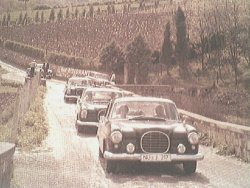| Back to the History of the 4 door sedans |
|
|
As early as 1956, Chief Engineer Fritz Nallinger gave the instructions for a new 'middle-class' 220. On September the 13th, 17th and 18th, long meetings were held by the Daimler-Benz management to discuss this new Mercedes. Nallingers instructions were: 1. Design a car that looks timeless with a hint of Italian design but with a recognizable Mercedes front. 2. Built a car with the safety cage principle. 3. Design a car from the inside out. |
 This entailed work for all departments: Josef Müller's engine team were to make their own contribution through even more responsive variants of the existing power units; Rudolf Uhlenhaut's team would look at the ride and handling improvements as well as the notoriously poor Mercedes-Benz brakes; while Karl Wilfert's stylists and body engineers (today they would be called 'designers') would have to consider how their body shapes and trimmings could best protect the occupants of the car in the event on an accident. The today well-known designer Bruno Sacco just started his career at Mercedes-Benz around this time and therefore helped to design this car. |
 The main contours of the car had been settled by 1957, and the first hand-built prototypes took to the roads in January 1958. In the more than 3.000.000 test-kilometers which followed, it was hardly surprising that a number of press photographers recognized the cars for what they were, despite the rather crude attempts to disguise the cars by Mercedes-Benz. All the prototypes were painted in a dark green colour, had different rear lights and false circular grilles instead of the well known Mercedes grille. Besides that, the test-cars were always accompanied by a fleet of Mercedes products were ever they went, sometimes a rival car like the Opel Kapitän could be found amongst the party. |
Of course, Mercedes resolutely denied all stories of forthcoming new models, but by February 1959, development had almost reached completion and Nallinger, Uhlenhaut, Müller and Wilfert themselves drove a group of four slightly disguised prototypes form Stuttgart across the Alps to Naples and back to reassure themselves that the new model really was ready for production. Pilot-production began in may 1959 with W111 six-cylinder variants only, and three new models were proudly displayed at the Frankfurt Show in the autumn. |
In those days, the cars were strikingly elegant, the styling followed contemporary Italian trends like those of Pinin Farina who started the trapezium look with the Fiat 1800/2100 (the same kind of styling can also be found on the Peugeot 404 and the BMC Farina's). Another styling trend, much different to the Italian style, was the American styling. The contemporary American cars often had large 'fins' on the back of cars and chrome was heavily used on their cars. Karl Wilfert, head of the styling department, would create a perfect mix of these two styles. The American fins were scaled down to almost invisible little tail-fins, hence their nickname: 'Fintail' or 'Heckflosse' ('Heck' meaning 'tail' and 'flosse' meaning 'fins'). Mercedes explanation for the presence of these fins was that they acted as an extra help when the car was reversing (the fins were clearly visible from the drivers seat and marked the end of the car; therefore parking backwards was made much simpler). Nevertheless its very obvious that Mercedes, for once, followed the fashion grills of other makers. |
| Back to the top |
| Previous: 1) Introduction |
| Next: 3) 1959: The 220, 220S and 220SE |